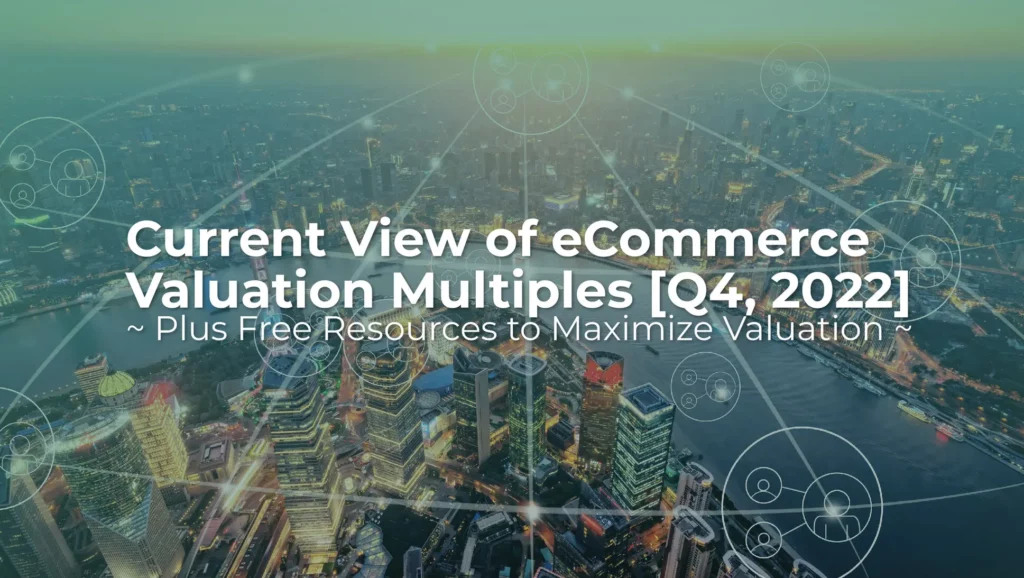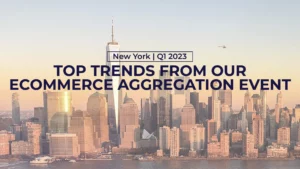Read Time: 5 Minutes
[Included Free Resources to Maximize your Valuation]
This year we hosted a panel discussion with seven lawyers with decades of eCommerce experience in both buy-side and sell-side M&A.
Both sides of the transaction agreed that if a founder had an unrealistic expectation regarding the valuation of their business (i.e. a valuation multiple that is not reflected in the market), it often led to an inability to renegotiate in due diligence, when issues would arise.
This would cause the deal to fail resulting in hundreds of hours in human resources and tens of thousands of dollars wasted.
If you are an eCommerce entrepreneur considering an exit in the near-term, having an accurate understanding of the valuation of your business better positions you to:
- Attract the right buyer: Each buying firm has a specific acquisition criteria. To pitch to the right firm you need to understand the valuation of your business.
- Aggressively negotiate the best offer (SDE/EBITDA multiple) within the bounds of the market.
- Close the deal.
In this article, we will provide an overview of the business valuation multiples we are seeing in the eCommerce market and the best way to price above the averages. Then we will provide a list of free resources that will help you maximize the valuation of your eCommerce business ahead of an exit.
Our data comes from multiple seller and buyer surveys, closed deals, expert panels discussions with industry thought leaders, and current market trends.
SDE | EBITDA
There are two principle models for assessing the profitability of a commerce business: Seller’s Discretionary Earnings (SDE) and Earnings before Interest, Tax, Depreciation and Amortization (EBITDA).
Calculated SDE is typically used for FBA acquisitions <$10 million, where the entrepreneur’s salary is considered discretionary and added back to the company valuation.
EBITDA is used to calculate the full operating costs (salaries included) of a DTC business generally >$10 million with multiple stakeholders, or a more complex governance structure.
Let’s start with SDE valuation multiples we’re seeing in the current market.
SDE Multiples for FBA businesses

Valuation multiples for FBA businesses currently range from 2X – 5X SDE. In smaller markets, the multiple range can be lower due to lack of competition.
This multiple range includes the deferred component: stability payment, earnout. However, it excludes any equity incentive, for example share options in the acquiring firm. A survey from Q4, 2021 found on average 75% of the final consideration was paid upfront. This number has softened in recent months, and will continue to do so as buyers look to offset risk in a volatile market with larger deferred components.
Naturally, equity incentives are increasingly becoming a viable option.
In a recent webinar, Zack Flint, Chief M&A officer for D1 Brands stated that brand aggregation in the future will be more of a partnership between Amazon seller and FBA aggregator. This way, they will share in the upside and also the risk.
Valuation Multiples Timeline | FBA Businesses
Our data shows that valuations peaked summer 2021 and remained high till Q1, 2022. Prevailing headwinds (H2, 2021) such as supply chain issues, and increased PPC costs made it harder for entrepreneurs to consistently increase revenue and margins. Lack of sustainability signals risk which began to impact valuation multiples at the start of 2022.
Q1, 2021 – institutional buyers pursued businesses with >$1 million revenue; by Q4, 2021 this increased to >$3million. Currently, many in our buyer network will only consider businesses >$5 million. Many aggregators are looking to do fewer, bigger deals (with some exceptions).
Q2, 2022 – it was evident that there was no appetite for average businesses. As one CEO said in our digital event in June, “Average is not good enough anymore.” With increased market constrictions came greater scrutiny around revenue, margin and brand. There was a consensus that many of the brands that sold a year ago would struggle to find an acquirer, today.
In June 2022, we surveyed 35 aggregators and found that 47% of their completed deals were 3X – 4X SDE.
Check out a full breakdown of the survey here.
EBITDA Multiples for Direct-to-Consumer (DTC) Businesses

Similarly, the multiple range for DTC eCommerce businesses (e.g. Shopify brands) peaked summer 2021 at 5X – 12X EBITDA having experienced higher consumer demand due to COVID. However, the iOS updates in Q2, 2021 began to limit consumer data on Facebook and Google, which began to impact recurring revenue and growth.
Currently, we are seeing deals in the multiple range of 2X – 9X EBITDA, which is a considerably wide range. These are typically much larger businesses, and the multiples exclude any equity incentives. In our experience, achieving the higher multiples are tied to attracting mid-market acquirers (>$10 million).

Source: Carta
However, war in Ukraine, rising interest rates and inflation have all impacted consumer demand, and Venture Capitalists (VC) have been investing less in consumer brands as a result (as image shows). These supply factors have made it more challenging to secure growth capital and scale a business into the mid-market, where the higher multiples are typically achieved.
How to Achieve the Higher Valuation Multiples | The Fortia Group

In a recent deal we completed, the difference between the highest and lowest offer was approximately 2X (including deferred).
With this degree of differentiation across the market, only the best prepared businesses with access to the deepest pool of potential buyers, will be able to inspire competitive bidding and command the higher multiples.
Experienced M&A Advisor = 25% Higher Offer
A seminal study from the University of Alabama spanning thirty years of acquisitions found having an experienced sell-side advisor increased the final consideration by up to 25%.
Experienced M&A advisors can achieve a higher valuations by:
- Preparing your business to go to market: Financial audits, supply chain and compliance audits, marketing optimization, detailed product roadmap – all of these need to be correctly rendered and articulated to attract the right buyer.
- Running a competitive auction: A direct sale tends to be less visible against the market, having the ability to conduct a competitive auction with a vast network of trusted acquirers (including P.E. firms and strategics) can spark a bidding war and drive up the valuation.
- Leveling the negotiation table: Businesses are typically sold at a lower valuation due to entrepreneurs with no M&A experience negotiating against well resourced buyers.
Are you considering an exit in 2023, but would like to better understand how to get the best offer? Contact us today for a free consultation.
Free Resources to Maximize the Valuation of your eCommerce Business
Here are eight free resources that will help you better understand the eCommerce market, prepare your business correctly, and exit for the best valuation.
Exit Guide for Amazon FBAs

If you are considering an exit, this 98-page companion manual is a must. With more than >40 contributors, our exit guide is considered the best in the industry.
Survey of Aggregator Valuations in 2022

In this piece we breakdown the data from a survey of 35 top aggregators.
Learnings include current valuations, deal-flow – and how to prepare your business to sell.
Best Tools to Grow FBA Brands

What makes this list essential is it is provided by four leading CTOs in the eCommerce – these are the tools they use to grow businesses.
Aggregator CEOs Discussing The Future of the Space

A two hour discussion with 10 of the leading minds and pioneers in the eCommerce space covering topics like capital structures and cash flow, and obstacles to selling your business in current market conditions.
Demystifying LOIs

Seven legal minds discuss the anatomy of the letter of intent (LOI) – what to expect and avoid – and its significance in the exit process. Watch this before you sign an LOI.
Acquisition Criteria of Buyers in a Bear Market

Eight heads of M&A for leading firms discuss buying criteria in a bear market – how to identify eCommerce businesses.
Valuations Deep-Dive

Six M&A experts from FBA and DTC aggregators take an indepth look at how much a business is worth in today’s market, and how to price above the average multiple range.
Red Flags in Due Diligence

Nine experts in eCommerce due diligence discuss what to expect and how to prepare. Topics include, lesser known aspects that can kill a deal, and when to retain an M&A, legal and financial advisor.






